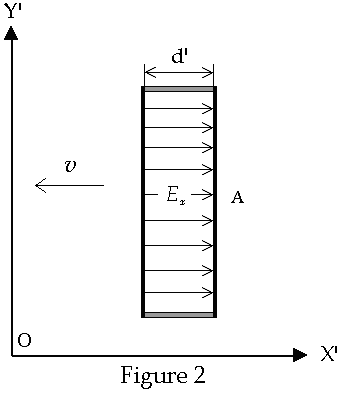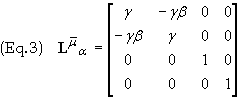
Back
to Physics World
Back to Special Relativity
Usually
no mention has been made as to how a
classical object could emit radiation. In order to be more precise and to
illustrate the differences between the mass of a particle and the mass of
a body focus here is placed on the internal details from two different
inertial frames of reference in relative motion. The term body will
denote an object with an internal structure, regardless of whether the spatial
dimensions are significant or not. It
is unclear how or if a structure-less particle could emit radiation. However a
body, having an internal structure, is quite capable of doing so. In analyzing
the details of the workings of such a radiating body one needs to be careful to
take into account the change in total energy as described by the
stress-energy-momentum tensor. Failure to do so could lead to an apparent
paradox [1].
To illustrate this idea consider as a model a parallel plate
capacitor, i.e. two plates, each of area A,
carrying equal and opposite amounts of charge and separated by a distance d.
Between the plates there will be an electric field of magnitude Ex. The energy density oof the field between the plates is uem
= e0
Ex
2
/2.
The capacitor is at rest in the inertial frame S, the x-axis aligned in
the direction of the electric field. See
Fig. 1 below

The
plates are held apart by struts. Design the struts so that they will snap
simultaneously as reckoned in the rest frame of the body at a chosen time.
The distance between the plates will then rapidly decrease, reducing the
volume between the plates and thus decreasing the total energy stored in the
electric field. As the plates accelerate to their new positions, the
accelerating charges radiating energy in the process. Thus the decrease in
energy of the capacitor is radiated as electromagnetic energy. For reasons of
symmetry the body would remain at rest. The frame S is moving in the
+x direction with respect to S with a uniform velocity v.
The x-component of the electric field is given by Ex
= Ex and is
thus invariant. All components of the magnetic field inside the capacitor vanish
in both frames. See Figure 2 below

Since Ex
is invariant uem
is
as well. However the distance between the plates decreases as 1/g
and therefore the energy between the plates must also decrease. Therefore the
mass of the field energy U does not transform as U = gU0
but as U0/g.
However, as noted by Rindler et al, the
mass of the supporting struts has been left out of this transformation. Since
the struts are under stress they cannot be ignored since stress in the rest
frame becomes part of the total energy in the lab frame. I.e. loosely speaking,
stress in one frame is energy in another. The proper mass of the struts cannot
be ignored since their proper mass figures into the total relativistic mass and
its total relativistic mass that must have the correct transformation property.
We must therefore utilize the mass tensor to obtain the correct transformation
for the relativistic mass. Let the proper mass density of the struts be r0
and the stress on the struts in the rest frame be T011.
In S the mass tensor for the struts is given by

Transform
to S
![]()
L
is the Lorentz transformation matrix whose components ![]() are
are

The
components of the mass tensor for the struts, in S, are thus found to
be

The
mass density r
and the x-component of momentum density gx
of the struts, as
measured in S, is given by
![]()
![]()
Let
the total cross-sectional area of the struts be da. The volume of the
struts in S is Vs = dda/g.
The volume between the plates as measured in S is V0
= Ad. The stress in the struts is
equal to the force per unit area required to keep the plates apart and is
therefore given by
![]()
The
mass of the struts in S is then

M0
is the proper mass of the struts and U0
= V0uem
/c2
is the proper mass of the electric field between the plates. The mass of the
field as measured in S is U0/g.
Let the proper mass of the rest of the capacitor (plates + charge) be C0.
The mass of this portion of the capacitor in S is C = gC0.
The total mass MT
of the entire moving body is

where
![]()
is
the proper mass of the body. The quantity
![]()
may
appropriately be referred to as the inertial energy. The momentum of the
struts is given by

The
total momentum of the system is then given by
![]()
Eqs.
(12) states that the mass of the body (i.e. the capacitor) transforms in the
same way as the mass of a particle and Eq. (13) states that the momentum of the
body is the mass of the body times the velocity of the body. The body as a whole
thus behaves as a particle with regards to mass and momentum, however each
individual part does not. Thus if a
rod is under stress then its mass and momentum will not have the same
transformation properties as that of a particle.
Now let the struts collapse, by each snapping into two
pieces, one of which then becomes the supporting strut. The other portion of the
strut can be included as part of C0 since
this portion of the capacitor, not under stress, transforms as usual. The total
change in mass is then determined by
![]()
According
to the assumptions made above, the decrease in the proper mass of the struts is
compensated for in our bookkeeping by absorbing the rest mass lost by the struts
into the rest mass of the capacitor structure, i.e.
DM0 + DC0
= 0
. The total energy of radiation observed in S will then be equal to the
change in energy of the electric field between the capacitor plates
![]()
Therefore
the energy
DU0
radiated by the body in the
body's rest frame transforms in the same way as the energy equivalent of a
particle with proper mass
DU0
/c2
.
The
weight of a body will depend on the structure of the body and the gravitational
field that its in. If the field is complex enough then the weight of the body
will depend on the orientation of the body in the field. The passive
gravitational mass of a body does not have the same properties as a point
particle. For such a body passive
gravitational mass is as meaningful as the charge is for a charged body with an
arbitrary shape. For such a charged object it is not enough to know the charge
of the body but one must know the charge and currents in the body in order to
know the forces acting on it; the 4-potential is required to describe the EM
force on the body. So too for the passive gravitational mass of a complex body;
the mass tensor is required to describe the weight.
References;
[1] A
simple relativistic paradox about electrostatic energy, Wolfgang
Rindler, Jack Denur, Am. J. Phys., 56
(9), September 1988, page 795.